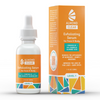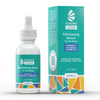What is Mandelic Acid?
What is Mandelic Acid and where did it come from?
Mandelic Acid is an alpha hydroxy acid (AHA) that’s derived from bitter almonds. MA is a skincare multi-tasking superstar that improves a wide variety of skin concerns like acne, folliculitis, hyperpigmentation, fine lines and wrinkles, ingrown hairs and dull skin. Plus, it’s gentler on the skin than other AHAs, so you’re less likely to experience irritation, redness, and excessive drying of the skin.
Although it seems like Mandelic Acid is relatively new to the skincare world, it’s actually been around for hundreds of years, right under our noses. So, where the heck did this powerhouse skincare treatment come from? Mandelic Acid was discovered in 1831, by German pharmacist Ferdinand Ludwig Winckler, who was heating amygdalin, (an extract of bitter almonds), with diluted hydrochloric acid. And BOOM ~ the birth of Mandelic Acid! It was soon discovered that MA has strong, naturally occurring antimicrobial properties, so during the early 1900s Mandelic Acid was commonly taken orally to treat urinary tract infections.

So, how does Mandelic Acid work its skincare magic? Like other types of AHAs, MA works by exfoliating the skin. Mandelic acid is a chemical exfoliant, meaning it removes layers of debris through a reaction with the skin, rather than exfoliating by abrasive scrubs. It very gently dissolves the tiny glue-like bonds that bind skin cells together, helping to remove dead skin build-up on the surface of the skin. But, unlike other AHA’s, Mandelic Acid’s molecule size is twice as big, which means it takes longer to penetrate the skin, and is therefore less likely to cause irritation. This makes Mandelic Acid perfect for those who have skin conditions that would benefit from using an AHA but also have sensitive skin.
Another super important quality of mandelic acid is that it’s naturally both antifungal and antibacterial. That means that applying it topically can help to control both bacterial and fungal acne (aka folliculitis). With its gentle yet potent skin-clarifying properties, it’s no wonder that Mandelic Acid is the favorite skincare acid of many skincare professionals like estheticians and dermatologists.

What skin conditions does Mandelic Acid treat and how does it help them?
MA is not only known to clear acne and fade wrinkles, but can also be used to clear folliculitis (a tricky skin condition, also known as “fungal acne”), can fade hyperpigmentation, lighten skin tone and even get rid of those pesky ingrown hairs. Plus, Mandelic Acid is excellent for people with darker skin tones! Let’s take a deeper dive into how Mandelic Acid works for each of these skin conditions!
Acne
Acne is a skin condition caused by an overproduction of dead skin cells inside of the pores.
What Mandelic Acid does
- MA clears stubborn clogged pores by exfoliating congested material like dead skin cells and oil. Once the congested material dissolves, it then exits the pore. No more clogged pores = no more pimples!
- MA loosens blackheads so that they can easily be extracted or fall out on their own.
- MA shrinks large, visible pores by dissolving trapped oil and dirt. Say goodbye to those pesky enlarged pores on the nose!
- MA has strong antibacterial properties, so it fights the bacteria inside of pimples that cause them to get red and inflamed.
Folliculitis
Folliculitis is a fungal or bacterial infection of the hair follicles that typically looks like many small red bumps (similar to non-cystic acne).
What Mandelic Acid does
- MA is strongly antibacterial and antifungal, so it clears up the microbes that cause folliculitis. No other AHA seems to have such potent antifungal properties that work for this specific skin condition.
- MA exfoliates dead skin cells and oil to unclog blocked hair follicles.
- MA has anti-inflammatory properties that greatly reduce the redness and inflammation that’s caused by folliculitis.
Ingrown Hairs
Ingrown hairs occur when a hair gets trapped beneath the surface of the skin and continues to grow inward. Ingrown hairs can be painful, and when they become infected with bacteria they can turn into swollen, red bumps or boils.
What Mandelic Acid does
- MA gently exfoliates the top layers of skin and removes dead skin cells that are blocking the hair so that the buried hair can come to the surface.
- Mandelic’s antibacterial properties help to calm the infection.
- MA’s anti-inflammatory qualities help to reduce swelling and redness.
Hyperpigmentation
Hyperpigmentation is when patches of skin appear darker than the surrounding skin, usually caused by acne scars and sun damage.
What Mandelic Acid does
- MA sloughs off dead skin cells from the surface of the skin, bringing new cells to the surface that replace the discolored layers. Over time with consistent application, dark marks fade away.
- MA has been shown to inhibit the production of melanocytes (melanin-forming cells) so the hyperpigmentation process is interrupted.
- Important tip: Make sure to wear sunscreen! Hyperpigmented areas are greatly darkened by sun exposure, so unless you want to make backwards progress on fading your dark marks, make sure to lather up!
Fine lines/wrinkles
Fine lines and wrinkles are characterized as creases, folds, or ridges in the skin that develop due to the skin becoming thinner and less elastic over time.
What Mandelic Acid does
- MA stimulates the skin to produce collagen and elastin. These two proteins naturally occur in the skin and are responsible for keeping it taught and plump. With the increased collagen and elastin levels that MA stimulates, the skin appears smoother and more taught, and fine lines are less obvious.
Dull Skin
Dull skin happens as a result of excess dead skin cells that build up on the surface of the skin that can make your face feel rough or bumpy, and can also give the skin a dull, lackluster appearance.
What Mandelic Acid does
- Mandelic acid exfoliates this dull skin, and works by dissolving the lipid bonds that hold dead skin cells together, and this allows buildup of dead skin cells to be removed from the surface of the skin. With the outer, dead layer of skin removed, plump new cells can rise to the surface, and these cells appear radiant, healthy and are smooth to the touch.
Mandelic Acid extra: It’s amazing for darker skin tones

People of color are prone to hyperpigmentation (dark or red scars that appear where a blemish once was). These dark spots often remain long after the breakout has cleared. Therefore, it’s important to get acne under control as soon as possible so that long-lasting scars don’t continue to form.
What Mandelic Acid does
- Because mandelic acid absorbs into the skin relatively slowly, it will never cause permanent darkening to the skin.
- Darker skin can also be prone to extreme dryness. Harsh acne products like benzoyl peroxide and salicylic acid can make the skin extremely dry, flaky, and ashy. Mandelic acid is less harsh and won’t lead to dull, dry skin.
The Big Takeaway
Mandelic acid has long been used for its antimicrobial and exfoliating properties, but it’s still one of the best kept secrets in skincare. If you struggle with blemishes, aging skin, hyperpigmentation, or ingrown hairs, then maybe it’s time to give a Mandelic Acid serum or cleanser a try!
Like what you read? Want to chat about skincare with people who have the same skin concerns as you? Join our Facebook Group- Almond Clear Skincare Support.








